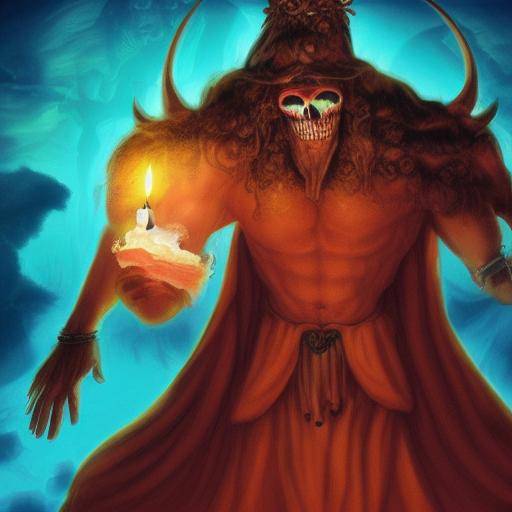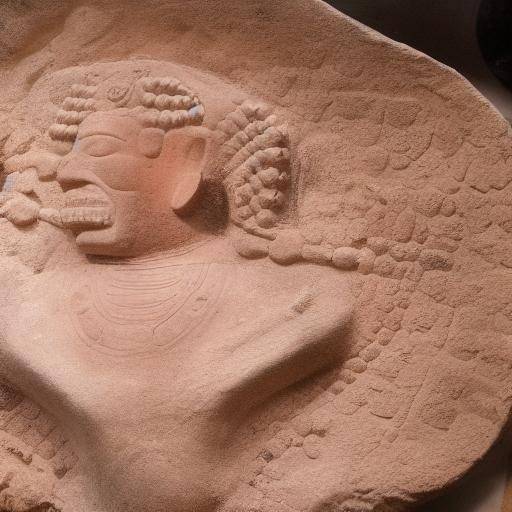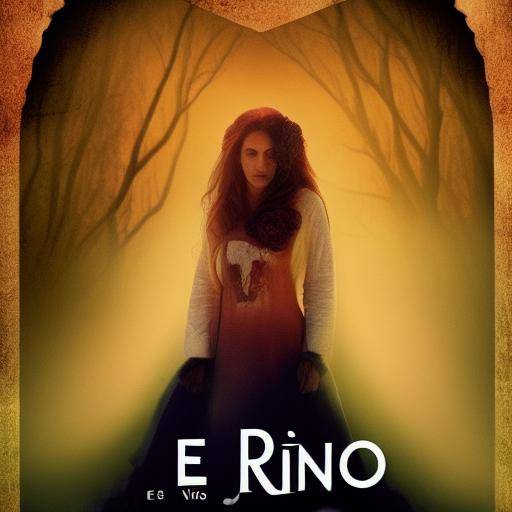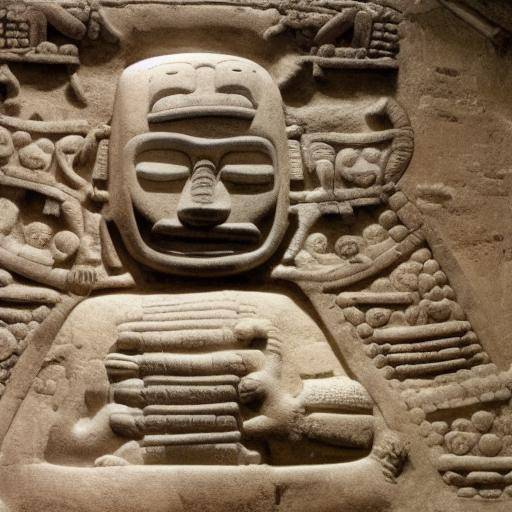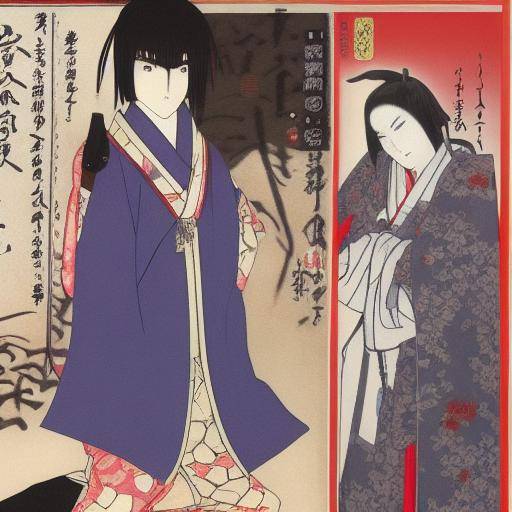
Introduction
The Japanese myths and legends come to life through their gods and deities, including Izanagi and Izanami, the creators of the world according to Japanese mythology. In this article, we will explore the fascinating history of these gods, their connection to the underworld, the birth of the islands of Japan and their meaning in Japanese culture. We will discover intriguing details of its myth of creation, its influence on Japanese religion and society, as well as its relevance today.
Prepare to be transported to a world of mythology and mysticism as we explore the riddles of Izanagi and Izanami!
The Myth of Japanese Creation
The Japanese mythology offers a wonderful vision of the origin of the universe, embodied in the divine power of Izanagi and Izanami. According to Kojiki and Nihon Shoki, two ancient texts that collect Japanese mythology, these gods played a crucial role in the foundation and configuration of the world.
Izanagi and Izanami emerged in the underworld chaotic, where they created the islands of Japan and gave birth to numerous gods and goddess. Their union and their actions formed the very fabric of the Nippon land, giving it a spiritual and symbolic richness that endures to this day.
History and Background
The history of Izanagi and Izanami dates back to the dawn of time, rooted in the very heart of Japanese culture. These primordial gods personify the fundamental forces that shaped the world, and their influence extends through centuries of beliefs and traditions.
The first written references on Izanagi and Izanami are in the Kojiki and the Nihon Shoki dating back to the eighth century. These texts collect orally transmitted myths and legends for generations, offering an invaluable view of the fundamental beliefs and values of Japanese society.
The narrative of Izanagi and Izanami also finds resonance in Japanese arts, literature and religion, permeating every aspect of Japanese culture and identity. His story is both a cornerstone of Japanese spirituality and a lasting symbol of the connection between man and the divine.
The Umbral of the Underworld
The underworld, known as Yomi, plays a crucial role in the history of Izanagi and Izanami. This dark underground kingdom, inhabited by the souls of the deceased, becomes the tragic scene of the separation of Izanagi and Izanami, marking the beginning of their divine drama.
Izanagi's incursion into the underworld in a desperate attempt to recover Izanami and his subsequent flight triggers a series of events that end up shaping the world as we know it. Thus, the underworld not only serves as a mythological scenario, but also symbolizes the duality between life and death, rebirth and transcendence.
Deep analysis
The myth of Izanagi and Izanami offers a rich source of reflection and interpretation, providing fertile ground for the analysis and understanding of fundamental concepts in Japanese mythology. From its metaphors on cosmic creation and order to its implications on life and death, this story transcends the barriers of time and culture.
Duality as Basic
The symbolism of duality permeates the history of Izanagi and Izanami, representing the opposite and complementary forces that shape the universe and human existence. This concept of duality is reflected both in his characters and in his actions, serving as an eternal reminder of interconnection and harmony in the very heart of Japanese culture. These primordial gods personify the fundamental forces that shaped the world, and their influence extends through centuries of beliefs and traditions.
The first written references on Izanagi and Izanami are in the Kojiki and the Nihon Shoki dating back to the eighth century. These texts collect orally transmitted myths and legends for generations, offering an invaluable view of the fundamental beliefs and values of Japanese society.
The narrative of Izanagi and Izanami also finds resonance in Japanese arts, literature and religion, permeating every aspect of Japanese culture and identity. His story is both a cornerstone of Japanese spirituality and a lasting symbol of the connection between man and the divine.
The Umbral of the Underworld
The underworld, known as Yomi, plays a crucial role in the history of Izanagi and Izanami. This dark underground kingdom, inhabited by the souls of the deceased, becomes the tragic scene of the separation of Izanagi and Izanami, marking the beginning of their divine drama.
Izanagi's incursion into the underworld in a desperate attempt to recover Izanami and his subsequent flight triggers a series of events that end up shaping the world as we know it. Thus, the underworld not only serves as a mythological scenario, but also symbolizes the duality between life and death, rebirth and transcendence.
Deep analysis
The myth of Izanagi and Izanami offers a rich source of reflection and interpretation, providing fertile ground for the analysis and understanding of fundamental concepts in Japanese mythology. From its metaphors on cosmic creation and order to its implications on life and death, this story transcends the barriers of time and culture.
Duality as Basic
The symbolism of duality permeates the history of Izanagi and Izanami, representing the opposite and complementary forces that shape the universe and human existence. This concept of duality is reflected both in its characters and in its actions, serving as an eternal reminder of the interconnection and harmony that balances the world.
The dichotomy between light and darkness, life and death, order and chaos embodies a fundamental principle in Japanese mythology, deepening the understanding of the cyclical and changing nature of the universe.
The Creation of the Japanese Islands
The birth of the islands of Japan at the hands of Izanagi and Izanami represents an act of transcendental creation and a physical manifestation of divine power. Each emerging island symbolizes a new stage in the gestation of the world, marking significant milestones in the formation of the Nippon land.
The Japanese mythology recognizes the islands of Japan as the home of the gods and the scene of numerous mythological events, consolidating its importance in the culture and mythical narrative of the country.
Exhaustive examination
The Cultural Influence of Izanagi and Izanami
The influence of Izanagi and Izanami transcends the mythological sphere to permeate Japanese culture, arts, religion and identity. His legacy endures through festivals, religious ceremonies and artistic representations, keeping alive his history and meaning in contemporary society.
The veneration of these gods as parents of Japan resonates in the collective consciousness of the Japanese people, strengthening the connection between past and present, tradition and modernity.
Reconstructing the Myth in the 21st Century
The myth of Izanagi and Izanami remains a source of inspiration and reflection in the modern era. The account of his love, suffering and transcendence remains the subject of academic study, artistic exploration and spiritual resonance. The contemporary adaptation of these ancient myths highlights its continued relevance in Japanese society and its ability to inspire new interpretations and expressions.
Comparative analysis
Meetings with the Underworld in Other Cultures
The notion of the underworld and the episodes of encounters with the kingdom of the dead manifest in the mythologies and religions of various cultures around the world. Comparison with these narratives reveals both similarities and differences, illustrating the universality of certain themes and the diversity of cultural approaches.
While the Japanese underworld is distinguished by its connection with the creative forces of the universe, its counterpart in other cultures reveals unique nuances that enrich the collective understanding of human experience.
The Birth of the Holy Lands
The account of the birth of the islands of Japan is a recurrent theme in various mythologies, highlighting the symbolic and spiritual importance of the places of origin in mythical narratives. Comparison with other accounts of the creation of sacred lands proposes an intercultural study that enriches the understanding of the relations between the earth, the divine and the cultural identity.
Practical Tips and Accessible Recommendations
Cultural Exploration of the Myths
For the enthusiasts of Japanese mythology and culture, immersed in the stories of Izanagi and Izanami offers a unique opportunity to understand the spiritual bases of Japan and its influence in contemporary society. It is recommended to explore books, documentaries, exhibitions and artistic representations that enrich the understanding of these fascinating creative gods.
Participation in Religious Festivals
Religious festivals in honour of Izanagi and Izanami offer an immersive experience in Japanese tradition and spirituality. To attend ceremonies, rituals and celebrations related to these gods provides an authentic view of their place in the religion and daily life of Japan.
Industrial Perspectives and Expert Reviews
Addressing Mythological Issues in Education
The integration of myths and legends into educational programs offers students the opportunity to explore Japan's cultural and spiritual wealth. Education experts advocate the inclusion of mythological narratives in the curriculum to promote intercultural understanding and appreciation for the spiritual heritage of the country.
Case Studies and Practical Applications in Daily Life
Mythological Inspiration in Contemporary Art
Contemporary artists explore the mythological themes of Izanagi and Izanami through various forms of artistic expression, from paintings and sculptures to installations and performances. The study of cases of artists and their works related to these gods opens a window to contemporary creativity and its dialogue with tradition.
Future Trends and Predictions
Revaluing Spirituality in the Modern Age
There is a resurgence of interest in spiritual and mythological roots in contemporary society, reflecting a desire to connect with timeless narratives that offer meaning, transcendence and guidance in a constantly changing world. This spiritual rebirth promises to influence the appreciation and continuous assessment of the myths of Izanagi and Izanami.
Conclusion
The story of Izanagi and Izanami, the creator gods of Japan, offers a unique window to the rich Japanese mythology and its impact on culture, spirituality and arts. Through their history in the underworld, the birth of the islands of Japan and its symbolic meaning, these gods transcend time and space, resonating in the heart and consciousness of people throughout the centuries.
The myths and legends of Izanagi and Izanami invite deep reflection on the duality, creation and connection between the divine and the human. Its influence persists in Japanese society, enriching the collective understanding of the cultural and spiritual identity of the Japanese country.
This article has explored the myths and legends of Izanagi and Izanami from various perspectives, offering an integral vision of their significance and transcendence in Japanese culture. Through veneration, academic study, artistic expression and integration into education, these creative gods continue to inspire and enrich the lives of those who dive into their story.
FAQs
1. What is the meaning of Izanagi and Izanami in Japanese mythology?
In Japanese mythology, Izanagi and Izanami represent the creative gods whose union gave birth to the world. Its history symbolizes the duality, creation and connection between the divine and the human, deeply affecting Japan's culture, religion and arts.
2. Why is the underworld so relevant in the myth of Izanagi and Izanami?
The underworld, known as Yomi, is crucial in the myth of Izanagi and Izanami, as it is the scene of his tragic separation and the starting point of his divine drama. The duality between life and death, and the search for transcendence, are reflected in their encounter with this dark underground kingdom.
3. How did the myth of Izanagi and Izanami influence the creation of the islands of Japan?
According to Japanese mythology, Izanagi and Izanami created the islands of Japan through a series of divine acts, symbolizing the birth and gestation of the world. These islands are considered sacred and host numerous mythological events, as well as being a fundamental symbol of Japanese cultural identity.
4. What are the most outstanding artistic representations based on the myth of Izanagi and Izanami?
The myth of Izanagi and Izanami has been represented in various artistic forms, including paintings, sculptures, dances, Noh theatre and literature. These representations reflect the richness and breadth of the influence of these gods in the artistic expressions of Japan.
5. Why is the myth of Izanagi and Izanami still relevant in contemporary society?
The myth of Izanagi and Izanami remains relevant in contemporary society due to its deep connection with Japanese culture, spirituality and arts. His transcendent history invites reflection on universal themes such as duality, creation and transcendence, resonating in collective consciousness.
6. What lessons can we draw from the myth of Izanagi and Izanami for modern life?
The myth of Izanagi and Izanami offers timeless lessons on duality, love, overcoming difficulties and transcendence. These lessons can inspire greater appreciation for the interconnection between the divine and the human, as well as a deeper understanding of the cyclical and changing nature of the universe.
We hope that this comprehensive guide on Izanagi and Izanami has been informative and enriching, and that it has unveiled the mysteries and the importance of these fascinating creative gods of Japan!

